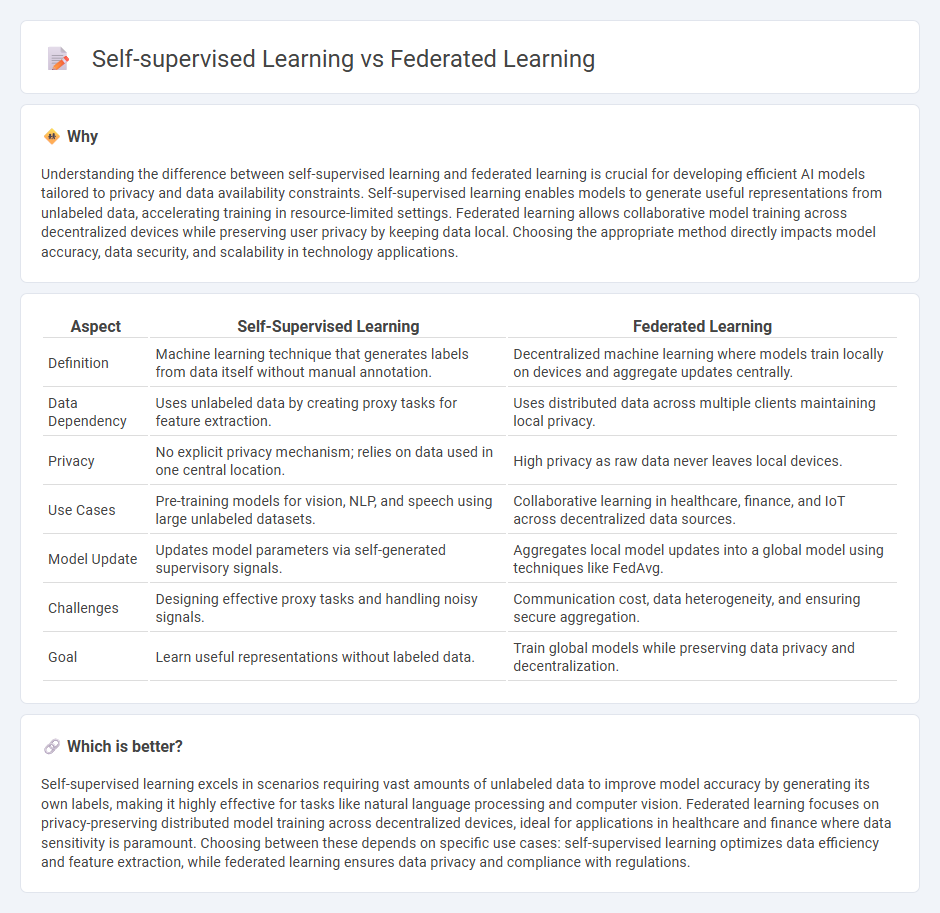
Self-supervised learning leverages unlabeled data by generating supervisory signals from the data itself, enabling models to learn useful representations without extensive manual labeling. Federated learning focuses on training models across decentralized devices or servers while preserving data privacy by keeping data locally and sharing only model updates. Explore the nuances and applications of self-supervised and federated learning to understand their impact on modern AI development.
Why it is important
Understanding the difference between self-supervised learning and federated learning is crucial for developing efficient AI models tailored to privacy and data availability constraints. Self-supervised learning enables models to generate useful representations from unlabeled data, accelerating training in resource-limited settings. Federated learning allows collaborative model training across decentralized devices while preserving user privacy by keeping data local. Choosing the appropriate method directly impacts model accuracy, data security, and scalability in technology applications.
Comparison Table
| Aspect | Self-Supervised Learning | Federated Learning |
|---|---|---|
| Definition | Machine learning technique that generates labels from data itself without manual annotation. | Decentralized machine learning where models train locally on devices and aggregate updates centrally. |
| Data Dependency | Uses unlabeled data by creating proxy tasks for feature extraction. | Uses distributed data across multiple clients maintaining local privacy. |
| Privacy | No explicit privacy mechanism; relies on data used in one central location. | High privacy as raw data never leaves local devices. |
| Use Cases | Pre-training models for vision, NLP, and speech using large unlabeled datasets. | Collaborative learning in healthcare, finance, and IoT across decentralized data sources. |
| Model Update | Updates model parameters via self-generated supervisory signals. | Aggregates local model updates into a global model using techniques like FedAvg. |
| Challenges | Designing effective proxy tasks and handling noisy signals. | Communication cost, data heterogeneity, and ensuring secure aggregation. |
| Goal | Learn useful representations without labeled data. | Train global models while preserving data privacy and decentralization. |
Which is better?
Self-supervised learning excels in scenarios requiring vast amounts of unlabeled data to improve model accuracy by generating its own labels, making it highly effective for tasks like natural language processing and computer vision. Federated learning focuses on privacy-preserving distributed model training across decentralized devices, ideal for applications in healthcare and finance where data sensitivity is paramount. Choosing between these depends on specific use cases: self-supervised learning optimizes data efficiency and feature extraction, while federated learning ensures data privacy and compliance with regulations.
Connection
Self-supervised learning and federated learning are connected through their shared goal of enhancing data privacy and efficiency in machine learning. Self-supervised learning enables models to learn from unlabeled data by generating their own labels, which complements federated learning's decentralized approach that trains models across distributed devices without sharing raw data. Together, they facilitate robust, privacy-preserving AI systems that leverage vast, diverse datasets while minimizing the need for centralized data storage.
Key Terms
Data Privacy (Federated learning)
Federated learning enables multiple devices to collaboratively train a shared model while keeping raw data localized, significantly enhancing data privacy by preventing centralized data storage. The decentralized approach mitigates risks of data breaches and complies with stringent privacy regulations like GDPR and HIPAA. Explore how federated learning ensures secure, privacy-preserving AI development without sacrificing model performance.
Labeled Data (Self-supervised learning)
Self-supervised learning leverages unlabeled data by generating pseudo-labels from the data itself, reducing reliance on scarce labeled datasets, unlike federated learning which emphasizes decentralized training across multiple devices but still often requires labeled data. This approach enhances model performance in scenarios where labeled data is limited, making it highly valuable for applications with abundant raw data but insufficient annotations. Explore further to understand how self-supervised learning maximizes data efficiency and quality in modern AI systems.
Model Aggregation (Federated learning)
Model aggregation in federated learning involves the secure consolidation of locally trained models from multiple devices into a global model without sharing raw data, enhancing privacy and scalability across distributed systems. Unlike self-supervised learning, which relies on data-internal signals to generate labels and improve model performance independently, federated learning prioritizes collaborative model updates to facilitate consensus from diverse data sources. Explore further insights into optimizing model aggregation strategies in federated learning frameworks for robust decentralized intelligence.
Source and External Links
What Is Federated Learning? | IBM - Federated learning is a decentralized machine learning approach where a global model is trained collaboratively by multiple nodes using local data without sharing the data itself, preserving privacy by aggregating model updates on a central server through iterative stages of initialization, local training, global aggregation, and iteration.
What is federated learning? - Federated learning enables multiple participants to collaboratively train an AI model by locally training on their private data and sharing only encrypted model updates to a central server, supporting various forms like horizontal, vertical, and transfer federated learning to handle different data relationships.
Federated learning - Federated learning is a machine learning technique allowing multiple clients to train a shared model collaboratively without exchanging raw data, focusing on heterogeneous and decentralized datasets and addressing challenges such as data privacy, local data heterogeneity, and unreliable client connections.
 dowidth.com
dowidth.com